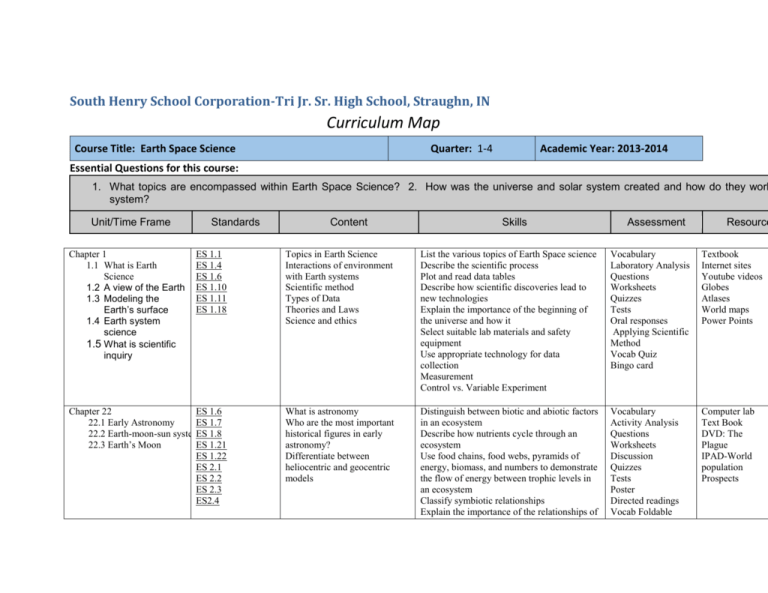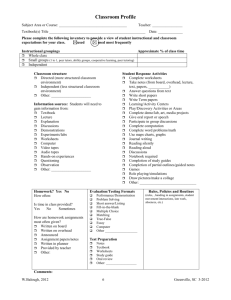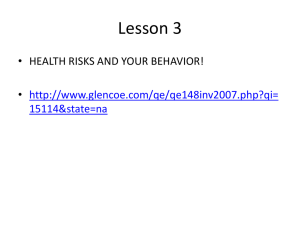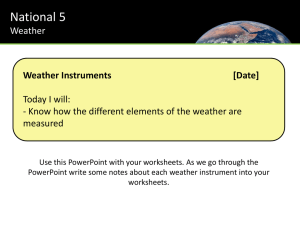Earth Science
advertisement

South Henry School Corporation-Tri Jr. Sr. High School, Straughn, IN Curriculum Map Course Title: Earth Space Science Quarter: 1-4 Academic Year: 2013-2014 Essential Questions for this course: 1. What topics are encompassed within Earth Space Science? 2. How was the universe and solar system created and how do they work system? Unit/Time Frame Chapter 1 1.1 What is Earth Science 1.2 A view of the Earth 1.3 Modeling the Earth’s surface 1.4 Earth system science 1.5 What is scientific inquiry Standards Content Skills Assessment Resource ES 1.1 ES 1.4 ES 1.6 ES 1.10 ES 1.11 ES 1.18 Topics in Earth Science Interactions of environment with Earth systems Scientific method Types of Data Theories and Laws Science and ethics List the various topics of Earth Space science Describe the scientific process Plot and read data tables Describe how scientific discoveries lead to new technologies Explain the importance of the beginning of the universe and how it Select suitable lab materials and safety equipment Use appropriate technology for data collection Measurement Control vs. Variable Experiment Vocabulary Laboratory Analysis Questions Worksheets Quizzes Tests Oral responses Applying Scientific Method Vocab Quiz Bingo card Textbook Internet sites Youtube videos Globes Atlases World maps Power Points Chapter 22 ES 1.6 22.1 Early Astronomy ES 1.7 22.2 Earth-moon-sun systemES 1.8 22.3 Earth’s Moon ES 1.21 ES 1.22 ES 2.1 ES 2.2 ES 2.3 ES2.4 What is astronomy Who are the most important historical figures in early astronomy? Differentiate between heliocentric and geocentric models Distinguish between biotic and abiotic factors in an ecosystem Describe how nutrients cycle through an ecosystem Use food chains, food webs, pyramids of energy, biomass, and numbers to demonstrate the flow of energy between trophic levels in an ecosystem Classify symbiotic relationships Explain the importance of the relationships of Vocabulary Activity Analysis Questions Worksheets Discussion Quizzes Tests Poster Directed readings Vocab Foldable Computer lab Text Book DVD: The Plague IPAD-World population Prospects Worksheets Discussion Quizzes Tests Poster Survival activity Design a food web Trophic activity Directed Reading Niche Posters Vocab Foldable Bingo card and numbers to demonstrate the flow of energy between trophic levels in an ecosystem Classify symbiotic relationships Explain the importance of the relationships of living things with each other and their environments Distinguish among individuals, populations, and communities Recycling of materials Chapter 23 23.1 The Solar System 23.2 The Terrestrial Planets 23.3 The Outer Planets 1.1 23.4 Minor Members of the Solar System ES 1.6 ES 1.7 ES 1.8 Terrestrial Planets vs Jovian Planets How the solar system formed Distinguishing characteristics of the terrestrial and jovian planets Location of asteroids, comets, meteors Compositions of the minor members of the solar system Interactions of environment with Earth systems Scientific method Types of Data living things with each other and their environments Distinguish among individuals, populations, and communities Recycling of materials List the various topics of Earth Space science Describe the scientific process Plot and read data tables Describe how scientific discoveries lead to new technologies Explain the importance of the beginning of the universe and how it Select suitable lab materials and safety equipment Use appropriate technology for data collection Measurement Control vs. Variable Experiment Bingo card Vocabulary Laboratory Analysis Questions Worksheets Quizzes Tests Oral responses Applying Scientific Method Vocab Quiz Textbook Internet sites Youtube videos Globes Atlases World maps Power Points Theories and Laws Science and ethics Chapter 24 24.1 Study of Light 24.2 Tools for studying Light 24.3 The Sun Chapter 25 25.1 Properties of the Stars 25.2 Stellar Evolution 25.3 The Universe Space Program Unit 1.2 1.3 1.7 1.8 1.10 1.17 ES 1.6 ES 1.7 ES 1.8 Discuss the theory of wave and particle energy/radiation Know the electromagnetic radiation spectrum and order of radiation based upon frequency and wavelength Distinguish between reflective and refractive telescopes Know the layers of the sun and its characteristics What can be learned by studying star properties Reading and analyzing the H-R Diagram Know the life cycle of a star Differentiate between stars based upon their mass Know the different types of galaxies Understand the Big bang theory Understand the expanding universe ES 1.5 ES 1.6 ES 1.7 ES 1.8 ES 1.10 Bingo card Read and use the EM spectrum Memorize the order the EM spectrum and visible light Building simple telescopes for lenses Draw and label the EM spectrum, telescopes, and sun Vocabulary Textbook Activity Analysis Internet sites Questions Youtube videos Worksheets (labeling) Power Points Activity/lab Lab manual Discussion Quizzes Tests Plot and read data tables Vocabulary Textbook Describe how scientific Questions Internet sites discoveries lead to new Worksheets Youtube videos technologies Quizzes Celestial Sphere Explain the importance of the Tests World maps beginning of the universe and Oral responses Power Points how it Applying Scientific Star finders Analyzing data tables Method Textbook Measurement Vocab Quiz Comparison of measurements Jeopardy Review Game and distance Draw an H-R diagram The beginning of space Memorization of space missions Vocabulary PowerPoints exploration Building a model of a space craft DVD’s DVD collection Who was involved in the space Explain the benefits of space exploration Model building Internet/research race Discuss the failures of the space programs Design a NASA and the various missions PowerPoint Test and quizzes Chapter 2 and 3 Minerals and Rocks ES 1.10 ES 1.11 ES 1.12 ES 1.13 ES 1.22 ES 1.23 ES 1.26 ES 1.29 Discussion of atoms and basic chemistry Characteristics of minerals and rocks Moh’s Scale of harness The production of various rocks and minerals The Rock Cycle Identifying minerals and rocks Investigating characteristics of Rocks and minerals Using Moh’s scale Rock Cycle game Chapter 4 Earth’s Resources ES 1.10 ES 1.11 ES 1.18 ES 1.21 ES 1.22 ES 1.25 ES 1.27 ES 1.10 ES 1.11 ES 1.17 ES 1.18 ES 1.22 ES 1.23 ES1.24 ES 1.25 ES 1.10 ES 1.11 ES 1.12 ES 1.17 ES 1.18 ES 1.23 ES 1.24 ES 1.28 ES 1.10 ES 1.11 ES 1.14 ES 1.15 ES 1.16 ES 1.21 Renewable vs Nonrenewable resources Processes used to obtain energy Alternative energy sources Research energy source Design a PowerPoint or brochure Present resource PowerPoint to class Chapter 8, 9, 10 The Earth and its Movements Chapters 12-13 Geological History Geological Time Scale Chapters 18-20 The Atmosphere and Meteorology Hands-on test of minerals and rocks Written test Fill-in/identify table of minerals and rocks Lab using rocks/identify various characteristics PowerPoint or brochure presentation PowerPoints Mineral and Rock Samples Internet research and rock identification tables Textbook PowerPoint notes Internet Textbook Resources worksheet Earthquakes Plate tectonics Volcanoes Causes of Earth movements Building a volcano Plate Tectonics Puzzle Using various scales to identify Earthquakes and their damage Worksheets Vocab quiz Written tests Building a volcano Textbooks Internet PowerPoint DVD Earth’s geological history The geological time scale The various periods of times and mass extinctions Dating ancient objects Design a representation of the geological time scale Using the half-life Puzzle of Pangaea Tree rings Lab activity Worksheet Vocab Quiz Written tests Textbooks PowerPoints Internet Lab worksheets The atmosphere Layers of atmosphere Clouds Meteorology Weather events Identify the layers of the atmosphere Identify cloud types Predict weather patterns based upon meteorology maps List the most damaging tornadoes and hurricanes in history Worksheets Labeling clouds Weather maps Vocab Quiz Written test Textbook PowerPoints Weather maps Lab worksheets






